an Overview
Axcient's Virtual Office is a powerful tool, designed to provide business continuity for your clients, but it can present a complicated environment to configure and manage.
What is Virtual Office?
The cloud failover feature in x360Recover allows you to start virtual machines in the Axcient Cloud of one or more protected devices. You can then create a Virtual Office running within the Axcient data center, using matching existing server configurations.
Virtual Office lets you self-manage using a secure, web-based application, which includes role-based authentication with required MFA.
What can you do with a Virtual Office?
- Configure network settings for that virtual office
- Provide secure access to that Virtual Office by configuring VPN
- Configure Site to Site Open VPN, so multiple remote networks connect to that Virtual Office
- Allow VMs to access the internet by enabling outbound connections (disabled by default)
- Establish Port Forwarding rules
- Start the Virtual Office VMs of each server from separate restore points
- Instantly recover production servers and workstations in the Axcient Cloud
- Perform regular full-office recovery tests to ensure backups are always recoverable
Here are some best practice guidelines to help streamline your recovery process.
Proper prior planning prevents poor performance ("The six P's")
The six P’s are never more important than when you are preparing for a real life disaster recovery.
Plan your disaster recovery process, prior to a real life disaster recovery situation.
Practice test cloud failover events to give your staff the experience they need.
Prepare a documented disaster recovery plan. Detail how you intend to handle various types of potential disasters that might occur.
|
What should you include in each plan? A single generic document is often sufficient for guiding your technical staff in various case requirements. However, detailed customized plans may be necessary for large clients, to understand every server, service, and system involved and to explain all requirements needed to recover efficiently.
|
Plan your network topology to include Virtual Office
Treat the Axcient Virtual Office as a separate remote site in your overall network topology.
This is a helpful approach when planning your process, whether you need to recover a single server or an entire site.
For example: Customer 1 has a main office and a secondary remote office location with site-to-site VPN connections linking them together.
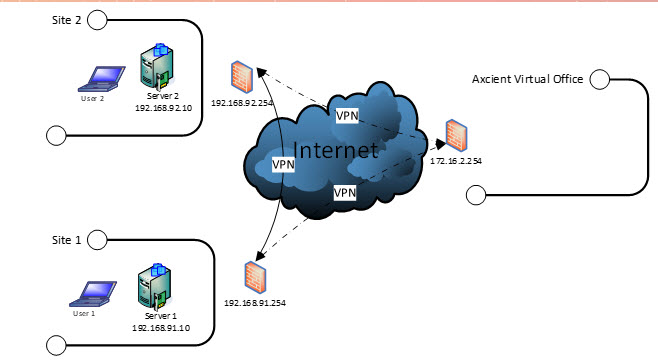
- When planning for potential recovery to the cloud, treat the Virtual Office as a new site on your network plan, with its own unique LAN IP subnet.
- When virtualizing a failed server in the cloud, simply change its IP address to the new subnet in Virtual Office.
For Windows environments, define this environment in Active Directory Sites and Services:
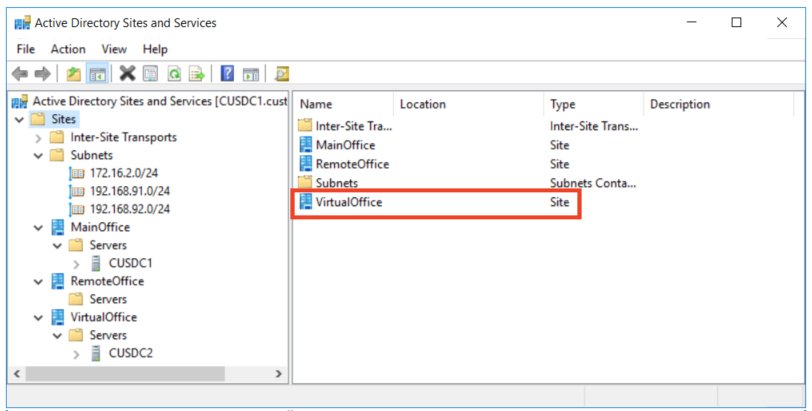
Note: If you virtualize a Windows domain controller, remember to update its location in Sites and Services. This will optimize Windows synchronization of Active Directory between sites.
Use runbooks effectively
Runbooks allow you to fully pre-plan your disaster recovery scenarios.
With a runbook, you can select and configure protected systems, organize network settings, set up port forwarding, arrange public IP addresses, and configure client and/or site-to-site VPN settings, among other tasks.
A runbook allows you to start up a Virtual Office and boot the most recent recovery point for each protected system - with just a few clicks of the mouse.
- Runbook limitations
While runbooks are undeniably convenient, there are a few things that runbooks can’t fully automate.
IPv4 Addresses are a limited commodity in the modern world. Unfortunately, Axcient doesn’t possess a limitless amount of IP space, so we cannot assign dedicated IP addresses to each partner.
This means that each time you start Virtual Office (whether manually or via a runbook), you will be assigned random IP address(es) from the available pool.
- When starting a test or live disaster recovery operation, you must update your VPN connections with the new peer IP address and the randomly generated pre-shared encryption key.
- If you are performing a failover for servers hosting publicly accessible services (such as mail or web servers), you must update your DNS ‘A’ records for such services to point to your Virtual Office IP address(es).
Provide efficient access to client services in the cloud
One of the most important aspects to consider when planning and performing a disaster recovery is how your clients will access their services when running in the cloud.
Here are three options, along with a discussion of why/when to choose each:
Site-to-site VPN - when the environment is intact
Site-to-site VPN is often the best option when the physical location and the user environments are still intact, and you simply need to fail over one or more servers.
In this scenario, you are relocating one or more servers to a different site.
If your internet bandwidth is sufficient, users may not even notice that servers are physically running somewhere else.
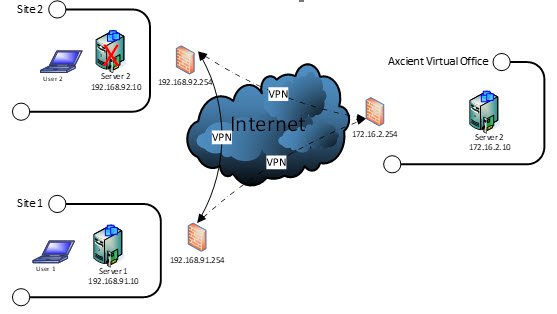
Steps for Site-to-site VPN:
- Launch a runbook
- Update your VPN connections with the new Peer IP address and password
- Change the IP address of the virtual machine Server to match the new LAN subnet.
- You may also need to update and sync Windows DNS and Active Directory changes across all domain controllers.
Client VPN - when users connect from another location
When an entire site outage occurs, there are usually no services available such as internet connectivity or power. Your users will need to relocate to another location with access to such services.
Typically, this relocation involves going to a home office or other location where power and internet can be found.
Roaming users will need to connect without the benefit of IT managed infrastructure (such as routers and site-to-site VPN tunnels.)
One method of providing this access is client VPN.
Please note that while a client VPN connection provides flexibility, using this method can be somewhat slower, depending on the applications being used.
Axcient Virtual Office provides client VPN via web browser and VPN client software.
When (Client) VPN services are enabled in Virtual Office, there will be a web-based URL created for the users to follow to get connected. For details, please see Configure VPN for Virtual Office
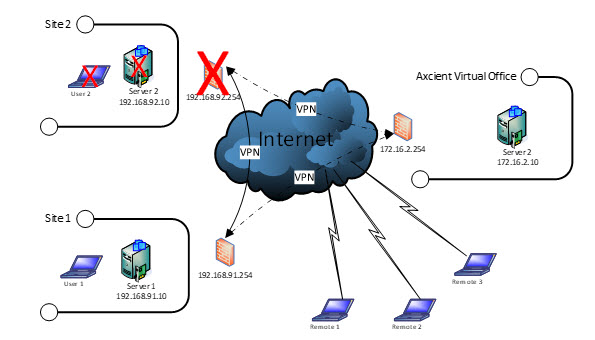
Steps for connecting to client VPN:
1. Roaming users connect via web browser to Virtual Office
2. Then, they login with user credentials, and connect over client VPN software installed directly onto their computers.
- Note: if the user has never connected before, they must download and install the client software from the Virtual Office login page.
User accounts for Client VPN logins may be pre-created within a runbook, or you may configure Active Directory LDAP authentication to leverage your existing Active Directory user accounts. (Configuration of LDAP integration is beyond the scope of this document.)
Remote Desktop Services (RDS)
Many clients prefer the flexibility of supporting remote and roaming workers in their everyday working environment.
One of the best ways to provide seamless remote accessibility to users is via Windows Remote Desktop Services (sometimes referred to as either Terminal Services or RDS.)
If your client's environment already includes servers supporting Remote Desktop Services, it is simple and straightforward to enable these servers to run in Virtual Office:
- Allocate an IP address for the Remote Desktop Services server virtual machine
- Port forward the required ports (typically 80, 443, and 3389)
- Update the DNS ‘A’ records (if you have one) to point to the IP address in Virtual Office.
Once DNS changes are propagated, clients can connect to their normal remote access address as usual.
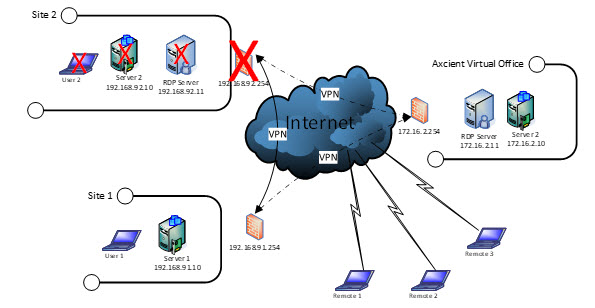
Supporting virtualized protected desktops
In some situations, you may have a client with complex vertical software environments - and such applications may not run well over a VPN.
- Or you might have some specialized users with vastly different application requirements than typical users.
- Or you could have cases where it is imperative that user desktops be individually backed up and ready for recovery.
Typically, in these kinds of scenarios, your clients would use an alternate computer, perhaps a home or personal system, to connect to a virtual machine copy of their normal work computer.
- In these cases, it may be best to use client VPN to connect the alternate computer system to Virtual Office and then use Remote Desktop Services over the VPN to connect each user to their own workstation machine.
Note: While it is possible to use port forwarding to allow direct Remote Desktop connections to multiple running workstation virtual machines, this is a poor practice. This exposes each machine to direct access over the internet. Connecting over a client VPN first adds an extra layer of security to your environment.
Example:
Lets assume that your client has a Remote Desktop Services server, as described above, which is used by the majority of users working remotely.
But your client also has a few users with sensitive data or vertical applications on their work computers that other users should not have access to.
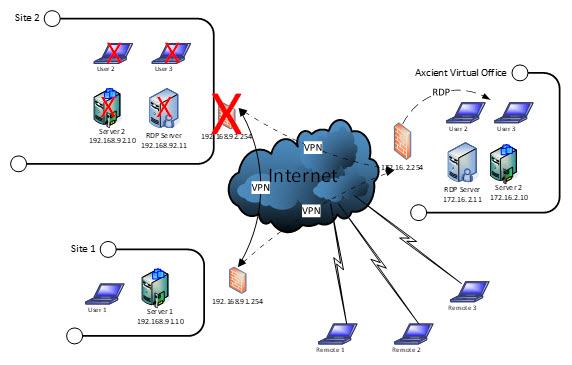
How could you best support this?
Users with special needs would access an existing tablet, home PC, or personal laptop to connect to Virtual Office.
They could then either
- directly connect to the Remote Desktop Services server for typical user access or
- connect via client VPN and then access the virtual image of their work computer using Remote Desktop Protocol. (RDP) RDP provides a rich, responsive remote desktop experience, up to and including support for sound if needed.
SUPPORT | 720-204-4500 | 800-352-0248
- Contact Axcient Support at https://partner.axcient.com/login or call 800-352-0248
- Free certification courses are available in the Axcient x360Portal under Training
- To learn more about Axcient products, sign up for a free one-on-one training
- Subscribe to the Axcient Status page for updates and scheduled maintenance
1428